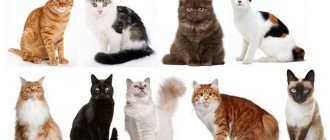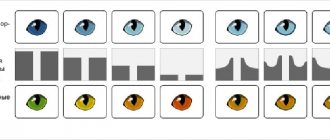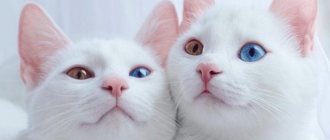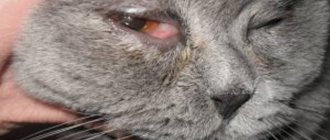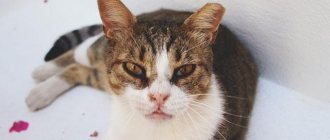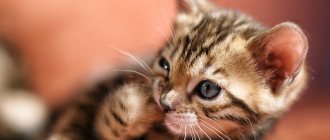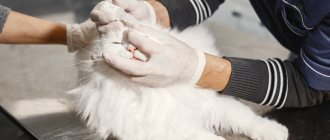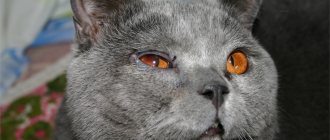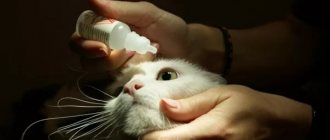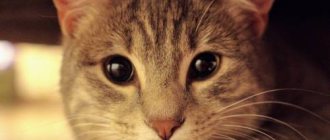Cats with heterochromia attract attention and arouse increased interest in everyone around them. Animals with eyes of different colors (blue and gold or emerald) look charming.
Breeders and ordinary hobbyists will need information about the name of the breed, where such an animal can be purchased, and in general, whether this feature is a criterion for identifying a separate breed.
Features of heterochromia
Cat fans have different views on this phenomenon. Some people deliberately look for such a pet and consider it a symbol of good luck and prosperity. They are rightfully proud of their unique cat, groom and cherish it, providing ideal conditions so that the pet remains a reliable talisman for as long as possible.
There are reasons for this attitude towards animals with different eyes. Many nations have a belief that the presence of such a cat in the house guarantees protection and helps the owner achieve any goal. Followers of Islam know that the Prophet Muhammad loved his odd-eyed pet Muizza very much. There is also modern evidence in favor of cats with heterochromia. As soon as Bill Clinton had such an animal in his house, he soon managed to win the election and become president.
There are also people among cat lovers who consider odd-eyed pets to be representatives of evil spirits. During the Inquisition, women with heterochromia were called witches and burned at the stake. Many eastern fortune tellers and sorcerers get a cat with different eyes in order to enlist the help of otherworldly forces.
And yet there is no reason to consider a pet with different eyes a bad sign. It is better to get acquainted with the scientific explanations of heterochromia and treat this phenomenon adequately.
Content Rules
Most often, cats with heterochromia do not require special care or special conditions. They, like cats of any other breed, are taught routine and order from early childhood. Eating, resting and outdoor games should occur at a certain time. The kitten gets used to the established rhythm of life, which contributes to a mutually comfortable pastime.
An important factor is toilet training the animal. Kittens learn this from their mother by observing and inheriting her actions. If you have acquired a very tiny fluffy, you will have to take care of his good habits yourself. The pet must be placed in a tray with litter immediately after feeding. Purebred kittens are very smart and clean, so they quickly get used to relieving themselves in a certain place.
It is important that the tray is located in an accessible and safe place.
Kittens are naturally active and playful, but you don't always have time to have fun with them. The consequences of independent cat games can be torn curtains, torn wallpaper or furniture. To prevent this from happening, it is necessary to accustom the animal to the right games. First of all, you need to buy or build a scratching post for your pet yourself. From the many toys in the pet store, you are sure to choose something useful and attractive for your cat.
Despite the innate cleanliness and neatness, sooner or later the cat will have to be bathed. This procedure will be especially relevant for animals with white and long fur. It is necessary to accustom a kitten to water procedures from early childhood, then the process of adaptation will be quick and painless. The water should be at a comfortable temperature - about 30 degrees; only special shampoo can be used as a detergent. For long-haired breeds, it is advisable to use conditioner to prevent tangling and electrification of the coat.
A cat, being in a limited habitat, needs proper and balanced nutrition, which you must provide it with. It is very convenient to feed the animal with ready-made dry or wet food. To make the right choice, just consult a veterinarian and carefully read the instructions on the package. A prerequisite is compliance with the recommended dosage of food. If you think that your cat deserves exclusively fresh and natural products, then get ready to diversify his menu with products such as:
- fish;
- meat;
- dairy products;
- cereals;
- vegetables.
When composing your pet’s diet, you should take into account the breed, age, gender of the animal, health status, and even the time of year and temperature of the food. To keep cats comfortable at home, you need to take into account their physiological characteristics. If you do not plan to breed animals, then for convenience and your own peace of mind, it is recommended to sterilize them. This simple surgical procedure is performed in a veterinary clinic.
Sterilization has a positive effect on the character and behavior of the cat and even helps prevent certain diseases.
Types of heterochromia
Experts distinguish several types of these anomalies. The criterion by which they are classified is the distribution of shades on the iris. Heterochromia can be:
- full,
- annular,
- sectoral.
In its full form, the anomaly appears as a uniformly colored iris. For the most part, one eye has a rich blue color, the other can be yellow, orange, green, copper, etc.
With ring heterochromia, both irises have the same shade. But on one of them there is a ring-shaped area, painted in a different color. A sectoral anomaly characterizes the presence of an area with a color that does not coincide with the general shade. This phenomenon can occur in one eye or both.
In most cases, a kitten is born with impaired pigmentation of the iris. Sometimes the anomaly is acquired; a change in the color of one eye is caused by certain external reasons. There are cat breeds in which heterochromia is a genetic trait.
Reasons for the anomaly
A congenital anomaly is not a disease; the body of an odd-eyed cat functions in the same way as that of ordinary pets. There are no changes in visual acuity. The only disorder that in some cases may occur in animals with different eye colors is poor hearing or complete deafness. Therefore, breeders of purebred cats discard such kittens and do not use them for breeding.
Heterochromia can occur in animals of any color. But most often, an abundance or deficiency of pigments occurs in pets with white, light fur, and tricolor cats. Typically, pronounced differences in eye color appear by three months of age.
Acquired heterochromia is a consequence of the use of certain medications or indicates the presence of a disease. For example, in the treatment of glaucoma, eye drops are used, the components of which activate the production of melanin. As a result, the iris takes on a darker shade. Lightening is often a sign of diseases:
- leukemia,
- melanoma,
- uevita,
- diabetes,
- neuroblastoma, etc.
Acquired heterochromia should be the reason for a visit to the veterinarian and diagnostic testing.
Deafness of odd-eyed cats
White cat with blue eyes: examples of breed names
Cats with white fur and blue eyes often suffer from deafness, and they have hearing problems from the moment of birth. Pets with different colored eyes are also prone to deafness. Scientists cite genetic disorders as the cause of this phenomenon. In the body of every animal there are 2 genes - one maternal and the other paternal. Moreover, if a gene responsible for deafness is passed from mother to child, but it is not passed on from father, then the former acts as the dominant one, which affects the kitten’s hearing problems.
Deaf animals are born that way right away.
The animal's ears contain organs that convert sound into electrical impulses that directly interact with the brain. In cases of a genetic defect, the transforming organ fails within a week after birth. And since in healthy kittens the ear canal opens only 1-2 weeks after birth, an animal with this genetic defect will not be able to hear a single sound in its entire life.
For your information! This gene also affects the animal's eyes, as a result of which the cat begins to see worse at night, which makes it a less effective hunter. As with other deaf animals, cats are prone to accidents, raise their voices more often, and are more aggressive.
Different eye colors as a sign of breed
Different eye colors are not always an anomaly. There are cat breeds in which this trait is inherited and is considered one of the characteristic traits. These include:
- turkish angora,
- kao mani,
- Turkish van.
Representatives of these breeds have a snow-white color or white is the main color in them.
Various disasters and wars have put the Turkish Angora breed under threat of complete extinction. The disaster was prevented by the attention of the Turkish government to these animals. Now cats of this breed are under state protection and are a national treasure.
The most expensive and rare pet is the Kao Mani cat. Since time immemorial, these animals have lived in Thailand. Short-haired snow-white cats, like representatives of the Turkish Angora, are protected by the state and are considered the national breed of Thailand.
The Turkish Van breed is the result of selection. The ancestors of modern representatives were wild cats living on the shores of Lake Van. The main prey of these predators is fish. Each hair of the thick, semi-long coat is well lubricated with subcutaneous fat. The cat does not get wet during water hunting.
It was the Turkish Vans that made odd-eyed pets popular. In the Turkish city of Van, a monument was erected to an odd-eyed cat. One eye represents the sun, has a golden tint, the second symbolizes the sky, its color is blue.
Heterochromia in animals of these breeds manifests itself similarly. One eye has a deep blue tint. The color of another iris can be amber, honey, green, orange.
Interesting facts about heterochromacy
In dogs, heterochromacy is most common in the Husky breed.
People are less likely to have different eyes, but, for example, David Bowie had one brown eye and the other blue.
People with heterochromic eyes often have vision problems.
The most beautiful cat in the world in 2022 was proclaimed the Turkish kitten Alosha - a snow-white baby with bright green and blue eyes with a slight braid. The pet is absolutely healthy and hears perfectly in both ears.
In the city of Van (Turkey), a monument to a heterochromic cat was erected, whose blue eye represents the sky and whose golden eye represents the sun.
There is a biblical legend about the odd-eyed Turkish Van. The cat caught a mouse that was destroying supplies on the ark, and Noah stroked his head in gratitude, which is why representatives of this breed have gold spots between their ears.
According to surviving myths, the favorite cat of the Prophet Muhammad, named Muizza, also had multi-colored eyes.
Heterochromia in other breeds
As an anomaly, different eye colors can appear in animals of different breeds. This phenomenon is often observed in cats:
- marble and tortoiseshell color,
- Persian,
- exotics,
- sphinxes,
- oriental,
- British, British
- Scottish,
- rex.
You can see odd-eyed cats among the yard tricolors. In most cases, different shades of the iris are formed in animals whose color white occupies more than half of the body area.
The manifestation of this feature is unpredictable and can occur in cats of any breed. There is only one condition for the formation of different colors of the iris. The animal must have a white gene that is inherited.
